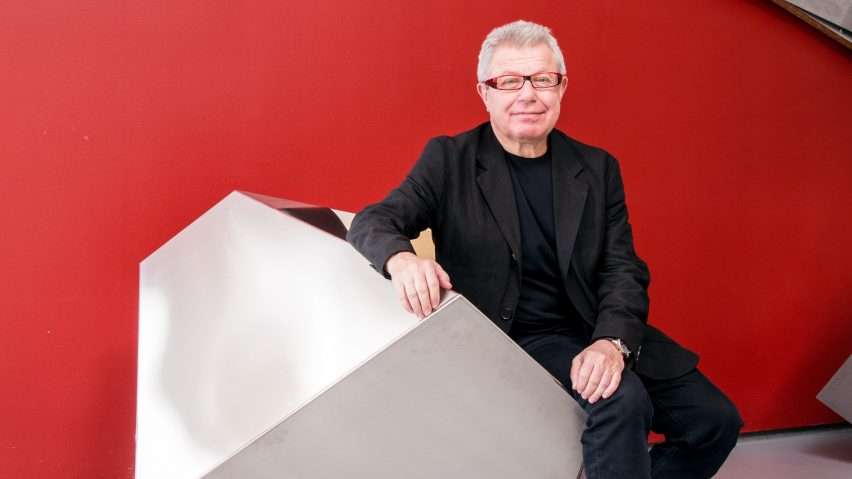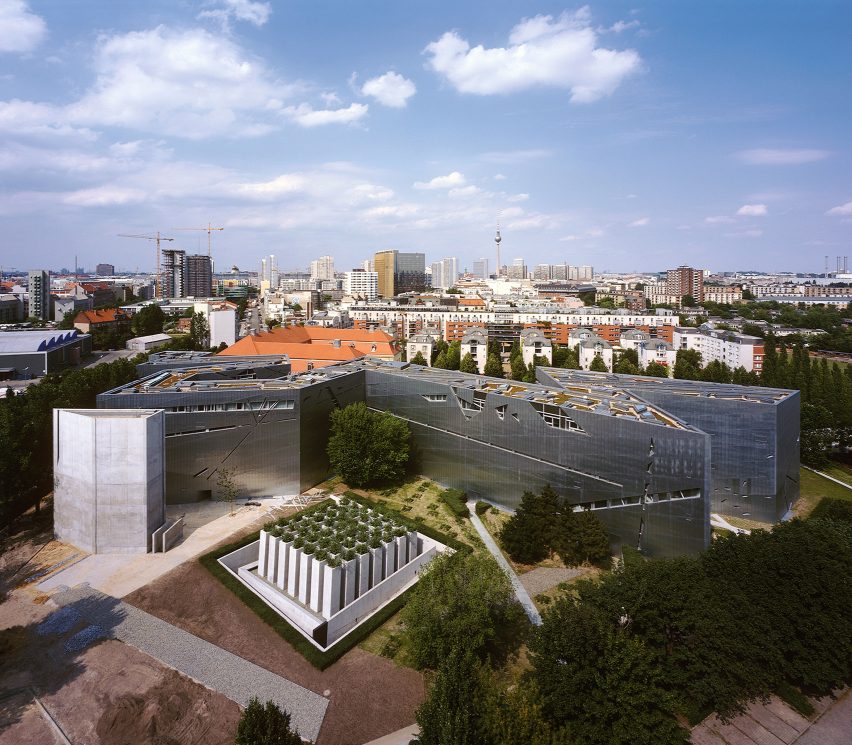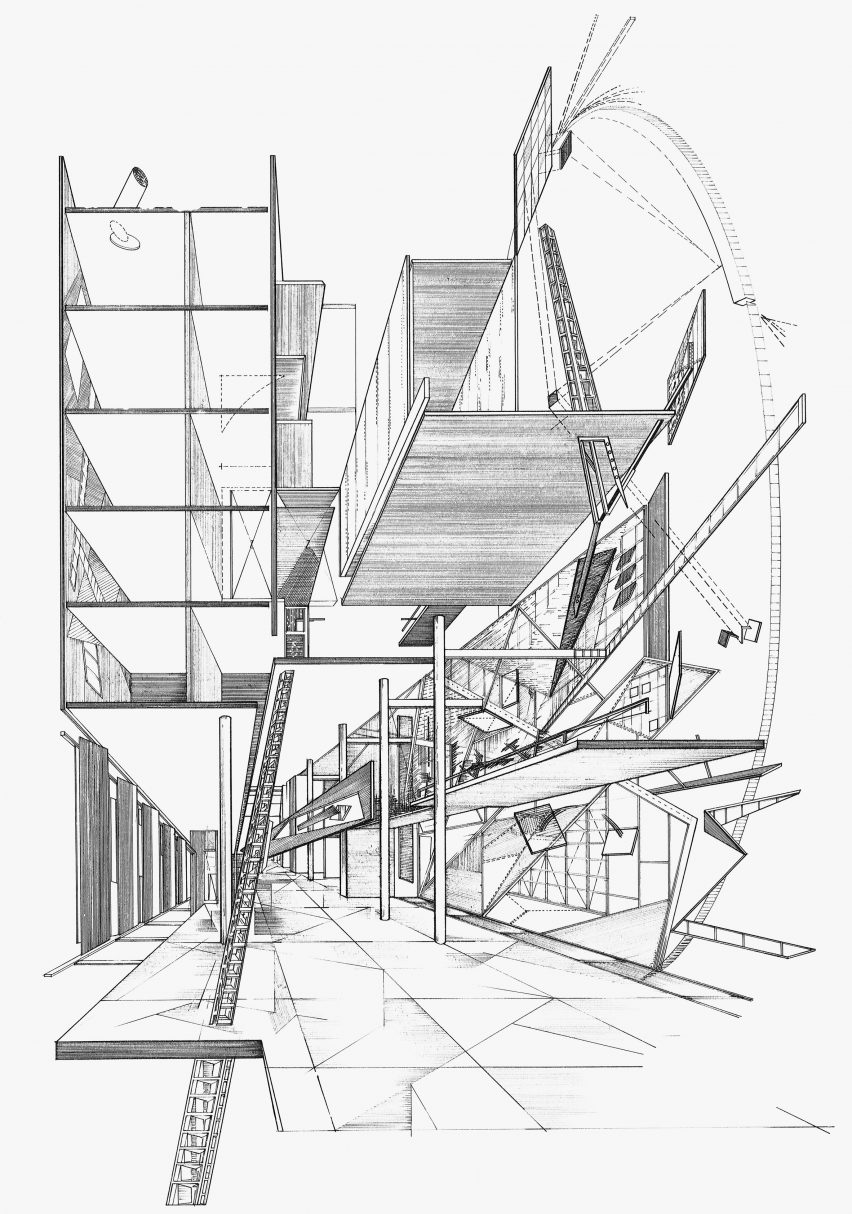
"I always felt slightly repulsed" by deconstructivist label says Daniel Libeskind
Deconstructivism was not a suitable name for the architecture that it represented, argues architect Daniel Libeskind in this exclusive interview as part of our series exploring the 20th-century style.
Polish-American architect Libeskind, who is considered a key proponent of deconstructivism, told Dezeen that the movement's name is better suited as a term for philosophy.
"The style doesn't mean very much to me," reflected Libeskind. "[Deconstructivism] was not a great word for architecture," he explained.
"I don't find usefulness in this term in architecture, I always felt slightly repulsed by it because it became a kind of intellectual trend."
"It has very little to do with how I view architecture"
Deconstructivism is a term that was popularised by an international exhibition at the Museum of Modern Art (MoMA) in New York in 1988. It derives from the deconstruction approach to philosophy and the architectural style of constructivism.
While being too philosophical for architecture, Libeskind also believes that the name has negative connotations, prompting thoughts of buildings "falling apart".

"I personally have always felt that [deconstructivism] was not a good term for architecture, because deconstruction in architecture seems to suggest falling apart," he said.
"It has very little to do with how I view architecture, which is really an art that has a grand history, that is social in its character, that is cultural and that has a huge longevity to it."
Deconstructivism is "not a style at all"
Though Libeskind does not have an affinity with deconstructivism today, he was one of seven renowned architects who took part in the seminal MoMA show. The others were Frank Gehry, Zaha Hadid, Rem Koolhaas, Peter Eisenman, Bernard Tschumi and Wolf D Prix.
At the time, he had never completed a building and instead presented a conceptual project called City Edge, which imagined the renewal of the Tiergarten district in west Berlin.
To Libeskind, the exhibition did not represent the emergence of an architectural style, but rather a turning point within the industry, just as it was "running out of ideas".
"[Deconstructivism is] not a style at all, but something in the air about the demise of former logic and former notions of harmony and former notions of beauty," Libeskind said.
"These architects had a very different idea than the sort of corporate and conventional styles of the late 1980s," he added, referring to his fellow MoMA exhibitors.

Libeskind explained that buildings of this era are all underpinned by an ambition to tear up the rule book and reestablish architecture as a form of art.
"It was the moment when architecture was again an art, when people realised that all these restrictions on architecture are really political and social and have little to do with the art of architecture," he said.
"It's no longer just something taken out of a catalogue of existing typology in a historical way."
Era of deconstructivism is not over
According to Libeskind, the MoMA exhibition show marked "a very important moment" in architectural history.
This is because its influence on architects continues to be evident today, and the era of architecture it represented is not over, he said.
"It wasn't a matter even of style, or a matter of the name, it was just something that has suddenly exploded into the world," explained Libeskind.
"In that sense, I think it was a very important moment of time, and we are still part of it."
"I think every student of architecture who goes to school today would not be doing what she or he is doing, without having a sense that something has happened to architecture that will never go back again," Libeskind concluded.
"That's thanks to this exhibition and this group of really brilliant architects."
Read on for the edited transcript of the interview with Libeskind:
Lizzie Crook: Firstly, could you tell me how you define deconstructivism? What does the style mean to you?
Daniel Libeskind: Well, the style doesn't mean very much to me. I think that it was a term used for an exhibition at the Museum of Modern Art many years ago. And it was a term, the term the deconstructivist, it was something in the air, something like the term existential was in the 60s, right? Everybody was an existentialist or postmodernist. So it's kind of a general term that is applicable to a period of time. And of course, the deconstructivist, to me, it's not a style at all, but something in the air about the demise of former logic and former notions of harmony and former notions of beauty, and a kind of delving into what underlies the contemporary experience of the intellect or the mind.
And as you know, deconstruction is a term that primarily was invented in philosophy, legal theory, sociology, psychology, and psychiatry, and it's attributed to Jacques Derrida, brilliant man. But I personally have always felt that it was not a good term for architecture, because deconstruction in architecture seems to suggest falling apart. But in fact, it has nothing to do with falling apart. I always thought that term is maybe more applicable to intellectual disciplines where you can kind of play with syntax and semantics, but not really applicable to architecture.
But being what it is, it's a term and people understand it as being something so contemporary, something different, something which is not about existentialism or the postmodernists, something about the contemporary issues that are around us. That's how I see it, I thought it was not a great word for architecture.
Lizzie Crook: Could you reflect on the 1988 MoMA exhibition and give me some context about this period of time, what was going on in architecture?
Daniel Libeskind: I think the tiredness of architecture, running out of ideas, running out of steam, sort of boredom setting in. And suddenly, the Museum of Modern Art brings together all these different characters, who are, I would say, have been friends with each other, they know each other because they are sort of a close, collaborative group and it creates a sense that something else is happening among the diverse architects. And unites them in a different search or quest for architecture. Which is certainly true, that these architects had a very different idea than the sort of corporate and conventional styles of the late 80s.
So yes, it was a kind of clarion call that something else was actually happening on the margins, which was not going to be marginal anymore but will enter the central discourse of what has been built in the world.
Lizzie Crook: So what were the key factors in the development of deconstructivism in architecture?
Daniel Libeskind: I think what defines this term in architecture is that architecture is something interesting, number one. It's no longer just something taken out of a catalogue of existing typology, sort of in a kind of historic, historical way.
I think what typifies it is sort of a quest for a sense of a new state, a quest for new materials, a sense of new social discourse with people who are going to be part of architecture or part of a city. A sense of something that is sort of awakened in an almost renaissance way, the longing for truth, and for beauty, and for a sense of authenticity, versus the sort of schlock architecture that that sort of roams around, no matter what period it is.
I think that's what typifies deconstructivism. That anything was interesting, anything that sort of transgressed the boundaries of let's say, what was conventionally acceptable. In a way, it was the moment when architecture was again an art, when people realised that all these restrictions on architecture, are really political and social and have little to do with the art of architecture.
So yes, I think it's part and parcel of a change of periods that it typifies, really by this very important exhibition at MoMA, because it was the first exhibition on the ground floor of the museum. Since the international show, all the other architecture exhibitions were really on the fifth floor somewhere where only an expert would find a way to, but this was a populist notion that this is for everybody. This is not for just some architects and analysts, it's really, people have to realise something has changed. So in that sense, I think it was a very, very important sort of moment of time in architecture.
Lizzie Crook: So how do you feel about being known as a deconstructivist architect?
Daniel Libeskind: Well I've never been…you know, it's a strange term. Though I have read Derrida, I've read many of the great writers, the contemporary philosophers, I don't find usefulness in this term in architecture. I always felt slightly repulsed by it because it became a kind of intellectual trend in architecture, which is certainly not how I see it. I mean, of course, there were intellectuals writing the catalogues and articles, and the connection between deconstructivist thought and architecture. But I thought, that it has very little to do with how I view architecture, which is really an art that has a grand history, that is social in its character, that is cultural and that has huge longevity to it. It's not just a matter of style or letter of form. It's something to me, very different. So I always felt that that term, may not be completely comfortable. And I don't think it made other architects there comfortable as well. If I think about it, maybe one or two, yes, but most of them.
Lizzie Crook: Have you spoken to your fellow architects who were part of the exhibition over the years and heard their feelings towards the label?
Daniel Libeskind: Look, these architects, it's a lucky group to be part of, because it's an incredibly creative group. And you can see since '88 how the works grew in different directions by different architects. So you can see that there was substance to the idea. In retrospect, it wasn't just some sort of a show at the Museum of Modern Art with a funny name. It was really a kind of a prophecy of what will happen in the world, including the fact that many of the architects had hardly built at that point. I don't think I had a single building to my name by the way when I was at that show. Not a single complete building, just models and drawings. So, you know, I have to say that exhibition was a sort of sense something inevitable is happening in architecture. And it will materialise not as a result of the exhibition, but as a result of the forces of reality pervading architecture in the world.
Lizzie Crook: So how exactly did the exhibition and this movement move forward the discussion of architectural styles?
Daniel Libeskind: Well, I think architecture changed dramatically. I think the sort of clever cliches of architecture, the clever quotations in architecture, the sort of humbug attributions of the meaning really evaporated with this kind of movement, because people saw that other capacities can really transform space, in a very pragmatic way. They saw these buildings arising that were interesting, that were different, that fulfil the other desires.
So I think, yes, I think it was really a sense that something true has happened, whatever, its name, whether you like it or you don't like the name, something else has actually happened. And it wasn't a matter even of style, or a matter of the name, it was just something that has suddenly exploded into the world. And I would say what exploded their world is a rediscovery of the potential of architecture, in terms of how to create spaces, how to get away from the sort of ready-made, commercial answers to problems, and how to innovate architecture with a sense of a kind of Renaissance or transformation.
In that sense, I think it was a very important moment in time, and we are still part of it. I think nothing which is happening today is not part of it, everything that sort of pushes the margins of what is possible everything which is on the cutting edge, whatever you call it, has to do with this moment of time.
Lizzie Crook: What are some of the key buildings that came out from this era of architecture?
Daniel Libeskind: Well, you could say deconstructivism is the Sydney Opera House, you could say deconstructivism is San Carlo in Rome by Borromini, you can say deconstructivism is you know, the radical, modernist, or some of the Gothic architecture. But you can also attribute it to the players in that exhibition, you know the names. Each one of them has produced buildings that have been correctly named deconstructivist because they were new, they were fresh. They look into the world that was obscured by layers of timidity.
I think people rightfully will, you know, we still call Heidegger existentialist and we still call John Paul Sartre existential, rightfully so, even though those labels are no longer really sort of vivid. But they do point to an era of time, that sort of had a new focus. And I think that's deconstructivist, I think it's a new focus, that will not evaporate, just like those philosophers have operated. And I just mentioned it, just like those thoughts are not permanently part of kind of the foundations of any intelligent look at society.
Lizzie Crook: It would be great to hear about some of your seminal works in the context of this conversation. Perhaps you could reflect on your design of the Jewish Museum in Berlin?
Daniel Libeskind: Well, you know, I never thought of myself as deconstructive as when I was doing the museum, that museum was part of my service. It was just sort of happening. But it is a building that challenges every facet of convention. You know, not a single staircase, not a single window or a single space is based on an obvious tradition. Of course, they are rooted in traditions of building, but they're challenging many of the assumptions.
And, of course, these assumptions were not challenged lightly, because they were dealing with assumptions about the genocide, the Holocaust, which is also unprecedented in human history. So in that sense, it's an unprecedented task I set for myself. That's the unprecedented programme that was to be fulfilled by a museum that has never been built before. Which is a museum in the place where the Holocaust started from Berlin, in Nazi Germany, and had to deal with how to create the story that really communicates to people what that period has to do with us today.
So yeah, I would say that's my first building, certainly, I never built any building before, not even a small one. And that certainly is a building that is different. That doesn't have some sort of obvious precedent. And it's a building that I think is on a quest to ask questions. It's not just answering questions. It poses questions to the visitors. It poses questions about orientation, poses questions about desire, poses questions about memory, poses questions about the future, poses questions about the past. So it's a building that, in many ways, in a nutshell, is what I was describing as quote-unquote, deconstructivist.
Lizzie Crook: So do you think the deconstructivist style of architecture can help the public connect with buildings more, so people who aren't trained in architecture? Because it's more expressive?
Daniel Libeskind: Yes, I think you're right, I think that works because it immediately brings up some sort of an expressive, or passionate sense of difference. So you know, if you say a building is postmodern, you think of a turret, you think of a building as classical you think of a Greek column. If you think a building is conventional, you think of a bland, you know, glass facade. But if you say deconstructive, you introduce a sense of anxiety to the conversation, you introduce a sense of rawness, you introduce a sense of something, like a gap that may even ring an alarm to somebody. And, of course, has rung many alarms, as we see the return of so many conventional, traditional and useless buildings.
So yes, I think the term has power. As I said, just like existentialism will always have power because it has the word existent in it. So deconstruction definitely has the power as a word, and maybe that's the virtue of having used it for it. Now that I'm speaking about it, that it raises that kind of alarm, and doesn't make you just, you know, go back into your dream world, but says something is happening here, and I don't know what it is.
Lizzie Crook: Would you like to touch on any of your other seminal works?
Daniel Libeskind: So really, every building that I pursued since my first building, which was the Jewish Museum in Berlin, whether it's museums of San Francisco or Denver or Dresden, or a house in Connecticut, or a performing arts centre in Dublin, or, you know, the new Maggie Centre in London, has the same kind of tendency, which is not to let architecture freeze itself and fall asleep, not to let architecture become just a kind of business proposition, just to build something. Because I really have very little interest in just building things.
Building something that has meaning, and maybe that is what deconstructivism is, really is. It's architecture that seeks meaning. Which is, I think, what brings us close to the philosophical sense of deconstruction in philosophy or literature that seeks to uncover what is there, but it's not readily accessible by the blinkers of anywhere on our eyes.
So yes, I would say that the final thing, for me, as I speak here, is that architecture is in search of meaning. And of course, meaning can be lost, it can become obscure, it can become forgotten, just like truth or beauty, or the good. But the quest for meaning, I think, is what makes architecture skill an art. And I think anybody who quests for that meaning, is to me, a deconstructivist architect.
You know I don't often think about it, but you made me really think about it. Because it's so interesting how the word itself and how what happened, as a result of using that word, is such an important political and social context of the Museum of Modern Art in the late 80s. And how the promotion of what it means has really had a very radical effect on lived space.
I think every student of architecture who goes to school today would not be doing what she or he is doing, without having a sense that something has happened to architecture that will never go back again to that neat encyclopaedia that Benevolo wrote, beginning 4,000 BC and bringing up to the present. Suddenly, the world became unpredictable. And suddenly, this line of history, this kind of historiography of encyclopaedic histories of architecture is over and we know that the next thing will be unpredictable, in every form. And I think that's thanks to this exhibition and this group of really brilliant architects.

Deconstructivism is one of the 20th century's most influential architecture movements. Our series profiles the buildings and work of its leading proponents – Eisenman, Gehry, Hadid, Koolhaas, Libeskind, Tschumi and Prix.
Read our deconstructivism series ›
The main photo of Libeskind is by Stefan Ruiz.